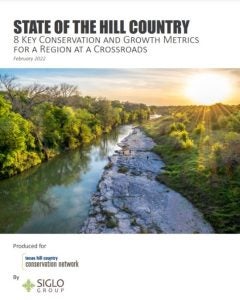In Presidio County, running water is a luxury that some residents do not enjoy. Families in Las Pampas, a Colonia near the Mexican border, must truck water from the City of Presidio to their homes north of town, spending money and time to secure what many Texans take for granted – running water and the economic opportunity this provides. Decades ago, when Las Pampas was first developed, a few groundwater wells supplied water to homes and even a restaurant, but the wells were poorly constructed and too shallow to access reliable underground water in this desert region. Eventually, they stopped flowing, and Las Pampas literally dried up. Read More
Growing Returns
Selected tag(s): texas water
For some Texans, a day without water is not imaginary – it is an unfortunate reality
Removing the mystery of groundwater to protect Texas’ beloved Hill Country
 What makes the Texas Hill Country unique? In my mind, it comes down to one thing: groundwater. It is impossible to overstate the importance of groundwater to this region, because without it, the Hill Country would not be the region we know and love.
What makes the Texas Hill Country unique? In my mind, it comes down to one thing: groundwater. It is impossible to overstate the importance of groundwater to this region, because without it, the Hill Country would not be the region we know and love.
It is the beauty and abundance of the Hill Country’s water resources that have attracted people here for thousands of years.
As the recently published State of the Hill Country Report reveals, the region is on the verge of becoming a victim of its own success as people are moving to the Hill Country in droves for its beauty and high quality of life. The report introduces eight key metrics to help track the region’s health and guide decisions that will determine whether the region will continue to thrive or live beyond its means.
Unfortunately, current levels of groundwater pumping threaten to dry up rivers and springs as the Hill Country heads down the second path of living beyond its means.
Wells and springs are drying up in Texas. Here is what leaders can do about it.
Millions of Texans are in danger of seeing their water supplies dry up as groundwater is being pumped out of aquifers across the state at an unsustainable pace.
Fortunately, there is still time for Texas to turn the tide and preserve groundwater for future generations.
Those are the conclusions of a new pair of reports released by EDF and the Meadows Center for Water and the Environment at Texas State University.
The first report Five Gallons in a Ten Gallon Hat: Groundwater Sustainability in Texas by Robert Mace, executive director of the Meadows Center, shows Texas is losing groundwater at nearly twice the maximum sustainable rate. Moreover, according to long-term management plans approved by local groundwater agencies, overpumping is likely to increase in coming years unless officials change course.
A second report co-authored by EDF, Advancing Groundwater Sustainability in Texas: A Guide to Existing Authorities and Management Tools for Groundwater Conservation Districts and Communities, lays out a path for addressing the looming groundwater crisis utilizing existing law.
5 principles for resilient groundwater management in Texas
Although Texas has a solid foundation for managing groundwater, this foundation is cracking under the combined pressures of increasing demand and decreasing supply.
These pressures are pitting rural areas against urban areas and landowners against each other, with groundwater conservation districts caught in the middle.
To overcome these challenges and ensure resilient water supplies, Texas leaders must improve the state’s framework for managing groundwater. That means finding common ground among diverse stakeholders on how to best sustain supplies.
Texas leaders made a big mistake ignoring water this session. But not all hope is lost.
Last weekend I paddled on the Blanco River with my family. We swam in spring-fed swimming holes, fly fished and lounged in shallow sections of the river, which was flowing nicely thanks to recent rains that ended drought conditions across Texas.
But it’s hard to ignore that Texas is sitting in the shadow of one of the worst droughts in history — one that’s crippling the rest of the West.
As temperatures rise and groundwater levels remain low with little rain in the forecast, it is imperative that we develop solutions to manage our water supplies more sustainably.
Unfortunately, state leaders put water on the back burner this legislative session, failing to take action on several water bills — even a benign bill to study groundwater and surface water interactions. But just because state leaders haven’t taken action doesn’t mean we can’t.
Here are three steps that all Texans can take now to build momentum behind protecting our rivers, streams and groundwater. Read More









